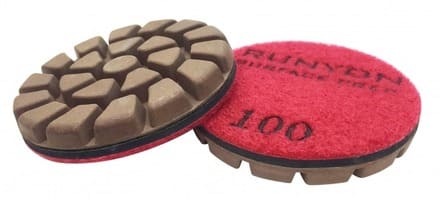As is typical of most abrasive equipment and accessories, the effectiveness of your grind or polish relies heavily on the quality of your attachments. Yes, the variations in the grit of tooling will make a difference in the fineness of the grind. But some tools of the same grit are better than others for different circumstances, and the reason why comes down to the quality and type of material built into the tool.
At Runyon Surface Prep, we offer a wide range of concrete surface prep equipment for rent or purchase. This post will highlight the significant ways that diamond tooling can make a difference in your project beyond the basic abrasion and polishing function and into higher quality tiers.
Tooling Grit and Surface Exposure Class
First, let’s talk a little about grit. The most influential factors in choosing the right tool grit are the hardness of concrete and the level of polish (or coarseness) of the finish you’re aiming for. Very hard concrete, for example, will require extra soft diamonds – whereas soft concrete will require hard diamonds. If you have the incorrect grit, you risk wasting time or causing more abrasion to the surface than you’re aiming for.
How Should My Surface Be After Polishing?
There are three primary classes denoting surface exposure after grinding and polishing operations. The exposure levels are also known as Cement Fines (Class A), Fine Aggregate (Class B), and Coarse Aggregate (Class C). Each class is separated by the percent of the surface material exposed, or as follows:
| CLASS | NAME | SURFACE EXPOSURE, % |
| A | Cement Fines | 85 – 95 % Cement Fines
5 – 15 % Fine Aggregate |
| B | Fine Aggregate | 85 – 95 % Fine Aggregate
5 – 15 % Blend of Cement Fines and Coarse Aggregate |
| C | Coarse Aggregate | 80 – 90 % Coarse Aggregate
10 – 20 % Blend of Cement Fines and Fine Aggregate |
Diamonds Can Differ From Tool to Tool
Once you’ve determined what grit(s) you need for your project, the next step is understanding how quality can make a difference and ensuring you get the right product for the job. The grit class will give you the size of diamonds in your tooling and, indeed, will associate with how fine the grind will be. But grit doesn’t say much for the concentration of diamonds.
One manufacturer, for example, may supply the same grit tool as another but their tool may consist of half as many diamonds; a cheaper alternative that may cost you in the long run. How so? You and other workers may find you’re spending more time than is necessary on the grind and on switching out tools. On that note, lower-quality diamonds will also wear faster and won’t perform as well. They can even scratch floors.
Types of Diamond Tooling
Different tools are made of different materials or combined with different materials, serving a range of purposes. Typically, tooling will consist of the following:
- Resin Bond: for polishing and light grinding and used with wet or dry resin tools.
- Metal Bond: for a wide range of concrete floor grinding needs.
- Transitional: often hybrid-style that provide cutting and grinding effects
- Polycrystalline Diamond: affordable yet offers an extended lifespan, these are made of synthetic diamonds and may be used for the removal of glue, mastic, and other coatings.
The biggest setbacks can come from cutting the smallest corners and from attempting a cheap surface prep. Quality and accuracy are key. Be sure you have the right setup for the job or you risk losing precious labor time or worse.
Concrete Surface Tooling and More at Runyon Surface Prep
At Runyon Surface Prep, we aim to be your one-stop shop for everything concrete surface prep. Between our wide spectrum of tooling options and dynamic catalog of equipment, we have what you need to get from point A to point Z.
Looking for diamond tooling? We also offer magnetic preload systems which make an easy switch-out for tooling attachments on power trowels, auto scrubbers, and swing machines.
Our equipment may be purchased or rented, and we ship internationally! Call us today or use the online contact form to get in touch.
